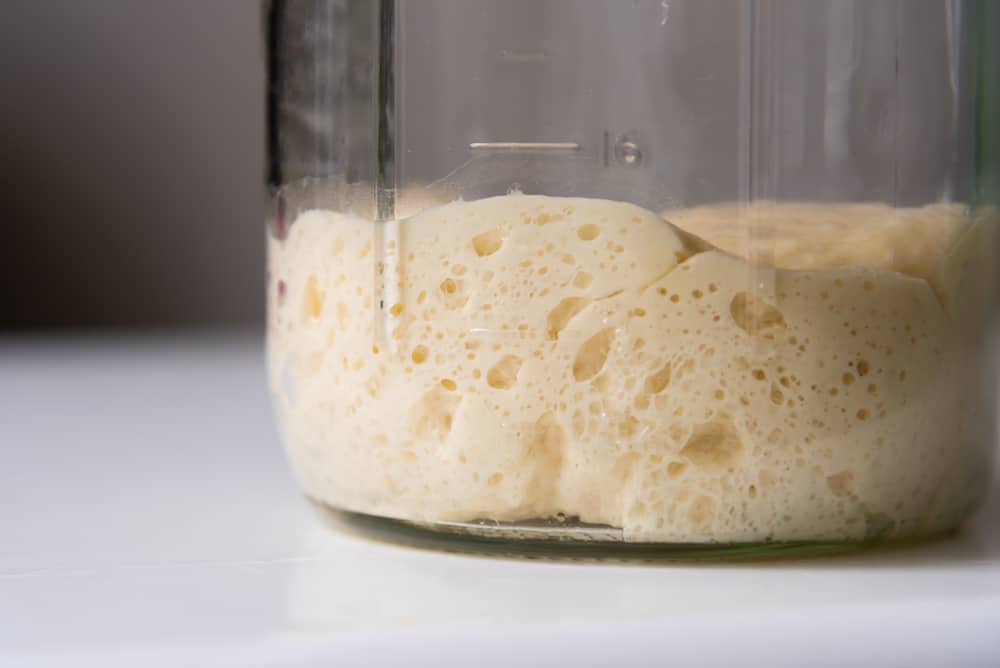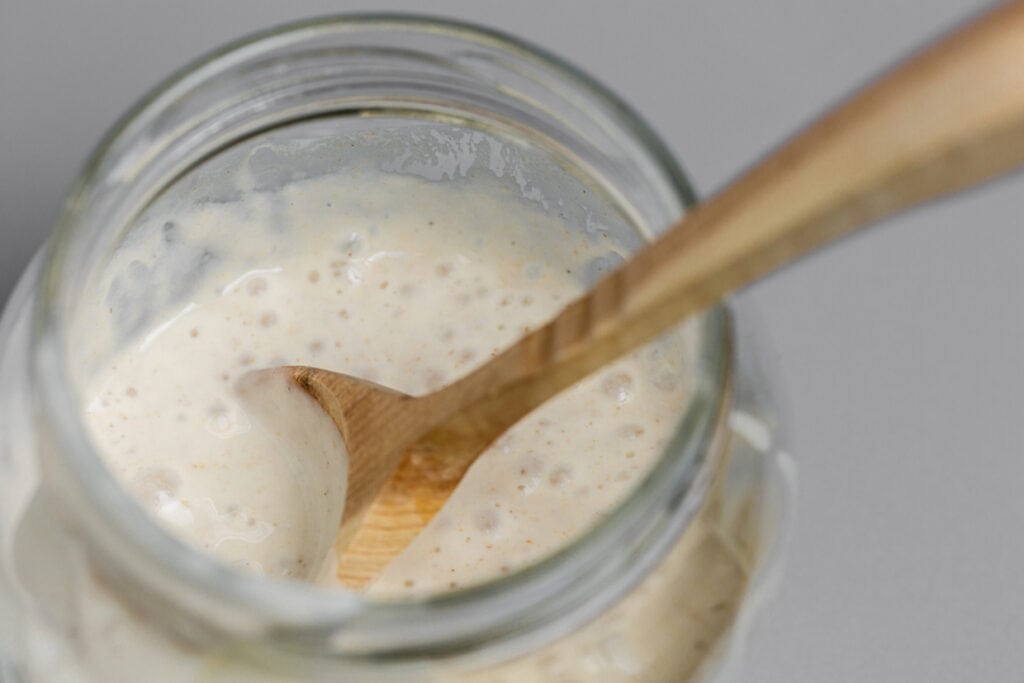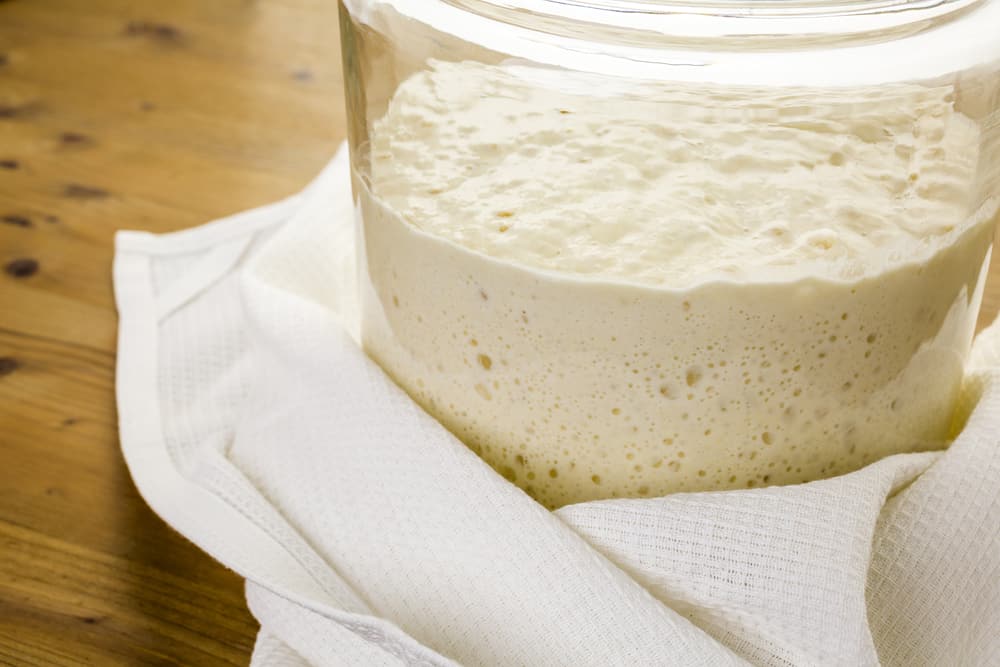Were you like the millions of people who became obsessed with sourdough bread when everyone was stuck at home a few years ago? Do you still have your sourdough starter from back then? If so, when was the last time you fed it? If it’s been a long time, then you’ll want to read on about the importance of caring for and feeding your sourdough starter.

The reason you need to feed a sourdough starter
You know how you have to water plants regularly to keep them alive? Well, it’s kind of the same with a sourdough starter. That’s because it is home to living organisms. Yeast cells are constantly consuming the flour in your starter, causing fermentation.
To keep that process going, you have to continue to nurture it. You cannot just mix the ingredients for a starter — flour and water — and expect to make great sourdough bread without regular care. These starters take time and need nutrient replenishment. Without that, you’re going to end up with a container of gross flour and water.
Temperature’s effect on a starter
You know Shakespeare’s sonnet that asks, “Shall I compare thee to a summer’s day?” Well, keep a summer’s day in mind when thinking about your starter — or at least the temperature you might experience on a pleasant summer day. Sourdough starters do best somewhere around 80 degrees Fahrenheit.
That’s why many bread enthusiasts like to keep their sourdough starter on a sunny windowsill during cold weather months. Or they learn this trick of finding a warm place for it after realizing that their sourdough starter hasn’t been working as expected.
Take Sarita Harbour of An Off Grid Life, who discovered that after a move to a cold climate, her starter suddenly stopped behaving properly. “When we moved to the Canadian subarctic many years ago, I couldn’t figure out why my sourdough starter took so long to start bubbling and frothing on our kitchen counter,” she recalled. “One day, I moved my starter jar to a shelf beside our wood stove, and that did the trick. So that’s where it lives when I’m baking daily.”
Feeding your starter on a regular basis
If you’re baking daily like Sarita, maybe because you’re on a sourdough pizza kick, then you’ll need to regularly feed your sourdough starter. Each time you feed it, remove the liquid that has formed on the top, scrape down the walls of the container, add equal parts water and flour and stir.
What is considered to be sourdough starter food? Simple: flour and water. Experienced bakers find that measuring out flour and water using a food scale works better than measuring cups. The scale provides more accuracy.

Do you have water with a high chlorine or mineral content? These can negatively affect fermentation in your starter. So, you may want to use store-bought spring or mineral water whenever feeding your sourdough starter.
Flour choices
Also, be thoughtful with your flour choices. All-purpose and bread flours are reliable sources for a starter. On the other hand, other flours can work against the natural fermentation process. This is true with self-rising flour.
According to King Arthur Baking, self-rising flour contains added baking powder and salt, which can interfere with the natural fermentation process and the balance of microorganisms in the starter. That’s why it’s best to use plain, unbleached flour without any added leavening agents or preservatives when feeding a sourdough starter.
Ideal container

Since you need to regularly observe your starter, many bakers opt for glass containers. Glass is also a good idea since you don’t want to risk any adverse reactions with plastic. If you have glass jars among your canning essentials, borrow one for your starter.
Still, some bakers are concerned that glass is fragile. Their years-old starter could be lost forever if they drop it. So, they opt for food-safe plastics. Ultimately, the choice is personal, but choosing a clear container is definitely a must.
Identifying feeding time

When is it time to feed your sourdough starter? You’ll want to look for visual clues. If you see any of the following happening — or not happening — in your starter, it’s time to feed it:
- Bubbles seem to lessen or have disappeared altogether.
- Your starter has a layer of liquid on top called hooch.
Any or all of these suggest that the naturally occurring yeast is out of nutrients and that fermentation has stopped. You’ll want to address this immediately.
If you see hooch, scrape it out — this is called sourdough discard, and you can use it in other recipes. Then, replenish the remaining starter with equal parts flour and water and stir to mix.
After that, add equal parts water and flour to the mixture every 12 to 24 hours or once to twice a day. You’ll want to continue feeding until you are done using the starter on a regular basis.
Also, keep the starter warm and at a consistent temperature. If it cools down, despite regular feedings, it won’t work as you’d hoped. Leave it too long at cooler temperatures, and you risk killing the fermentation process and destroying the starter altogether.
Storing your starter
Once you’re done needing an active sourdough starter, you can let it go dormant. The best way to do that is to put it in the refrigerator. That way, it won’t continue to ferment on the counter and eventually die out because you haven’t been feeding it.
This is how Michelle Price of Honest and Truly has managed to keep the same sourdough starter alive for four years. “I’ve had really good success with keeping it in the fridge when I go on vacation and cannot feed it,” she explained. “The cold temperatures slow it down.”
If your starter has been in the refrigerator and you’re ready to use it again, two things have to happen. First, it will need to warm up to room temperature at the very least. If your home is cold, try the sunny windowsill or near a wood stove to warm it up faster.
Second, you’ll need to feed it again now that you’ve reactivated the fermentation process by warming it up. Get back on a regular feeding schedule, with intervals of every 12 to 24 hours. Soon enough, your sourdough starter will be well-fed and ready to make homemade bread,

Final thoughts
Keeping a sourdough starter alive through regular feeding takes some work. But the effort is worth it. Some families are so successful with starters that they pass them down from generation to generation. Why not make this tradition part of your baking journey, too?
Leah Ingram and her husband Bill Behre recreate their grandparents’ Jewish and Italian recipes, respectively, along with new, favorite dishes on their blog Bagels and Lasagna.